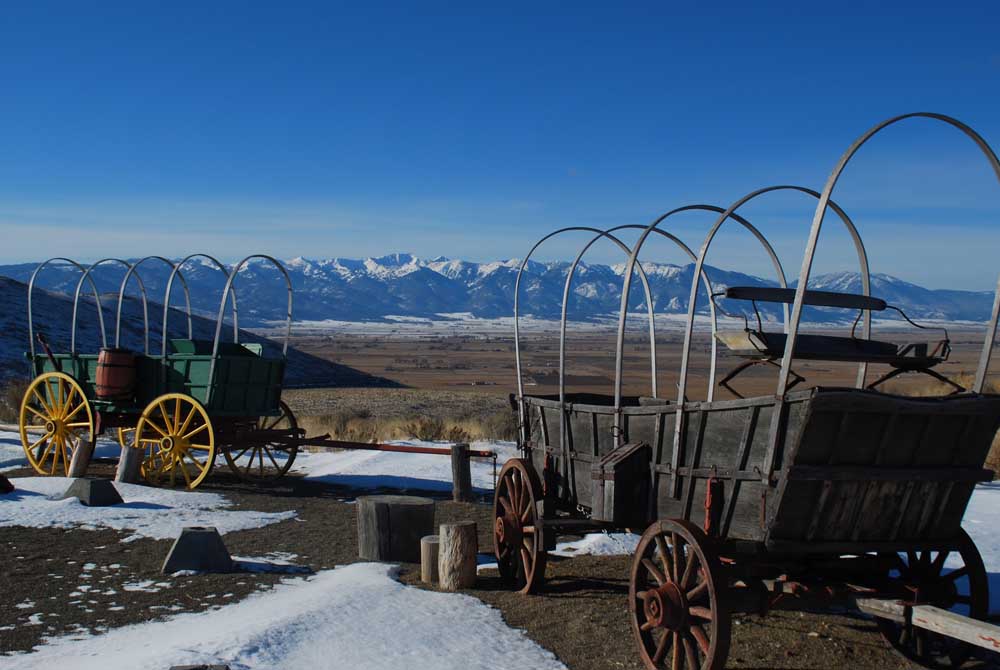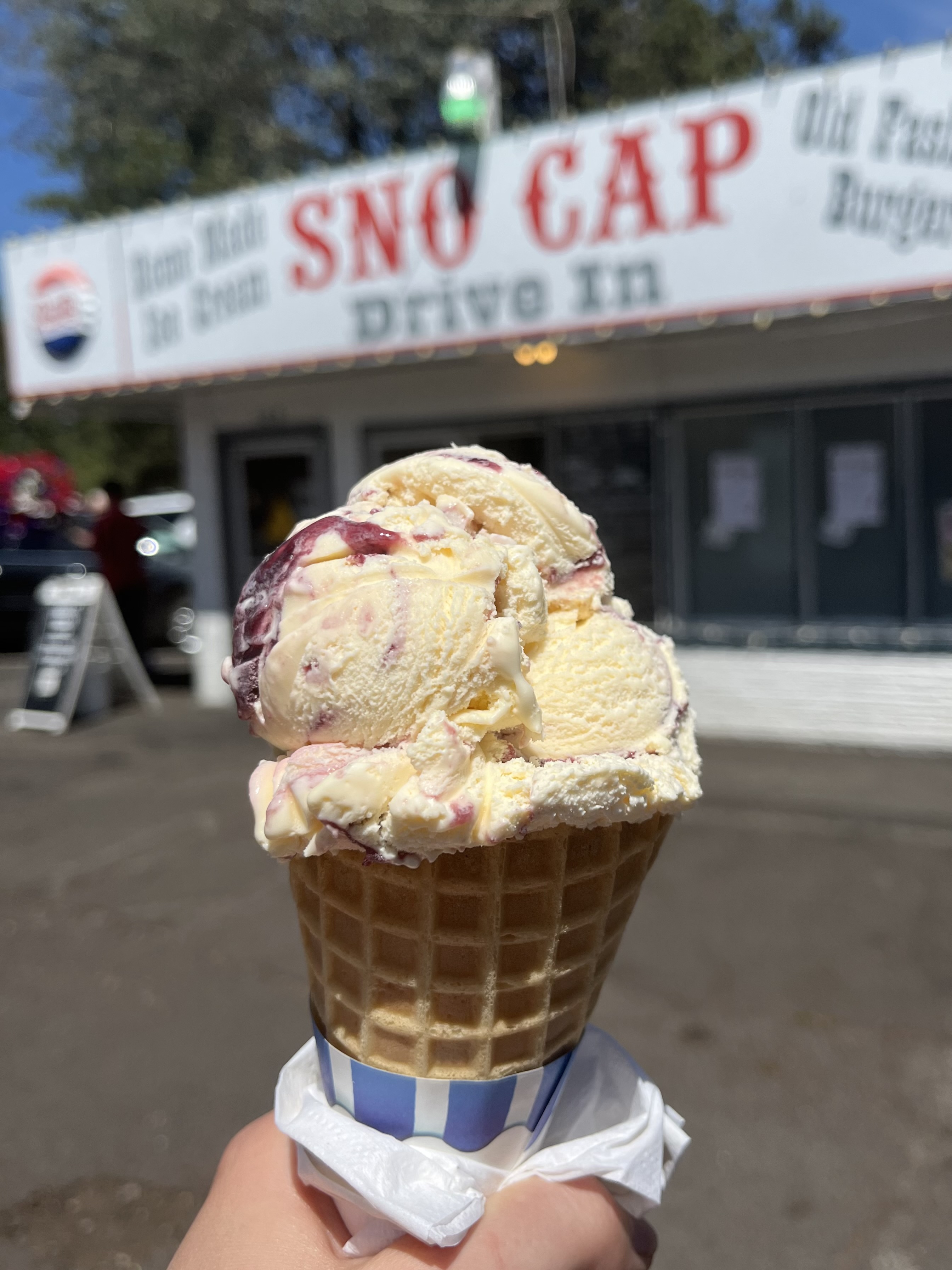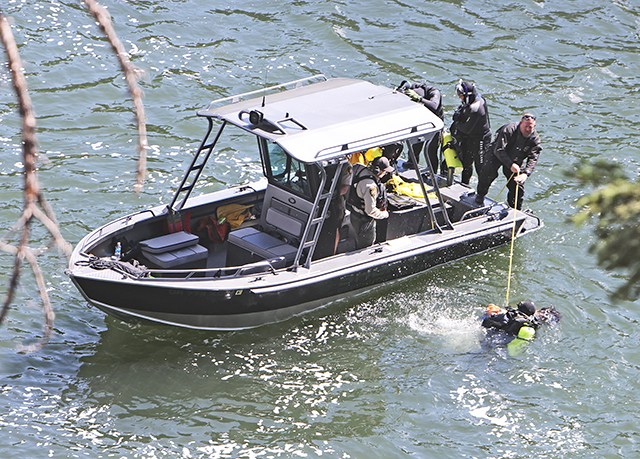Northwest Travel: Beauty and interest on the I-84 corridor
Published 12:00 am Sunday, January 10, 2016

- Barb Gonzalez / For The BulletinEmigrant wagons, now uncovered, still frame the Elkhorn Mountains at the National Historic Oregon Trail Interpretive Center east of Baker City. The gold-mining community of Sumpter and the Anthony Lakes winter resort are hidden in the distant peaks.
I don’t know that it’s true, but I’ve heard it said that Bend is farther from an interstate highway than any other city of 80,000 or more in the lower 48 states.
Consider: Bend is 108 miles east of Interstate 5 at Brownsville, 131 miles south of Interstate 84 at The Dalles. Central Oregonians spend plenty of time on narrower U.S. and state highways, but relatively little on four-lane (or greater) superhighways.
Trending
If you’re in Portland, on the other hand, you practically live on the interstate. You don’t ever have to leave I-5 as you drive north to Canada (283 miles) or south to Mexico (1,100 miles). Likewise, if you’re eastbound, as to Boise or Salt Lake City, you follow I-84 through Oregon for 374 miles until you cross the Idaho border at Ontario.
For Central Oregonians, sections of the highways are convenient, especially for those people making the drive to Portland. And if we Bendites are heading northeast — to Pendleton or Walla Walla, the Tri-Cities or Spokane — we inevitably travel a 75-mile section of I-84 between Biggs Junction and Hermiston.
This primer offers basic information for anyone traveling between Portland and Ontario along Interstate 84. It is unlikely many Central Oregon residents will follow the entire route, but the information on each of the seven major towns east of Portland — Hood River, The Dalles, Hermiston, Pendleton, La Grande, Baker City and Ontario — can be used individually.
Hood River
A town of about 7,500 people, just 60 miles east of Portland, Hood River is the gateway to the beautiful Columbia River Gorge National Scenic Area. Bluff-top lookouts and spectacular waterfalls can easily stretch an hour’s drive into half a day. Hood River is renowned as a recreational hub, both for wind surfing and kite sailing on the Columbia River and snow sports on nearby Mount Hood. An orchard center for apples and cherries, the town has many more cideries, wineries and breweries than its small size might suggest.
What to see: The No. 1 sight along this stretch of Interstate 84 is Multnomah Falls. At 620 feet, it is the second-tallest year-round waterfall in the United States (after California’s Yosemite Falls). A large parking area allows access to a restaurant and gift shop, and to a moderate trail that climbs to a bridge crossing the stream that links the 542-foot upper falls with the lower falls.
Trending
A large park beside the Columbia River is a great place to watch scores of colorful board sailors on the waves on any warm breezy day. Nearby, at the edge of downtown, the historic Mount Hood Railroad has a terminus for excursions through the orchards to the village of Parkdale, in the Hood River Valley. A worthwhile museum stop is the Western Antique Aeroplane & Automobile Museum, with a remarkable and occasional interactive (Model T driving lessons) collection.
Where to stay: There’s a lot of history at the Columbia Gorge Hotel, built in 1920 overlooking the river by Portland timber baron Simon Benson, and its early years a major draw for celebrity guests. Surrounded by lovely gardens, it retains its heritage flavor. Somewhat more moderately priced are the Best Western Plus Hood River Inn, whose Riverside restaurant has windows on the water, and the quaint (and centrally located) Hood River Hotel. For budget watchers, the Riverview Lodge is well maintained and close to downtown.
Where to dine: My favorite restaurant in Hood River is Mike and Shawna Caldwell’s Stonehedge Gardens, a large former residence in a delightful woodland on the west side of town. The menu is decidedly Pacific Northwest; the crab cakes are especially wonderful. Other good choices: Bette’s Place for breakfast, the Sixth Street Bistro for lunch, Celilo or Brian’s Pourhouse for dinner. And you can’t go wrong with a meal at a local brewpub, including Double Mountain and Full Sail.
The Dalles
The Dalles marked the point where 19th-century Oregon Trail travelers were faced with the choice of continuing down the frightening Columbia River rapids to the Willamette Valley or taking the harrowing Barlow Road around Mount Hood to their final destination. As such, there are numerous historic sites in this city of 14,000, including the old Fort Dalles.
The Historic Columbia River Highway, dedicated 100 years ago as the nation’s first scenic highway, has its eastern end in The Dalles. To the west, it rises through the Rowena Loops into the Columbia River Gorge National Scenic Area.
What to see: In interpretive and often interactive exhibits, the Columbia Gorge Discovery Center & Museum chronicles the geology and history of the river, from native tribes through the Lewis and Clark expedition to modern growth. Upriver on the Washington shore, the community of Maryhill features the memorable Maryhill Museum of Art, whose highlights include bronze work by the renowned French sculptor Auguste Rodin, and a First World War memorial constructed to resemble Britain’s neolithic Stonehenge monument.
Where to stay: I am partial to the Celilo Inn, on a hillside east of town, overlooking The Dalles Dam. A major makeover several years ago added real charm to a property whose approach road might lead one to believe otherwise. On the west side of The Dalles, Cousins’ Country Inn has a new, upscale addition in its “Steelhead Wing” and a restaurant and lounge that offers three meals a day. A solid choice in the city’s downtown area is The Dalles Inn.
Where to dine: Beside the railroad tracks and a stone’s throw from the river, the historic Baldwin Saloon has been a local institution since 1876. In later years a saddlery, it reopened as a restaurant in 1991, with a historic atmosphere but a modern steakhouse menu for dinner and lunch. Two other great local casual dining choices are Petite Provence (breakfast and lunch) and the Rivertap Pub & Restaurant (lunch and dinner).
Hermiston
Its location near a major rail and highway junction (where Interstate 82 branches off I-84 for Washington’s Tri-Cities) has contributed to the emergence of Hermiston, with 18,000 people, as Oregon’s largest city east of Bend/Redmond in recent years. Famed for its watermelon farms, Hermiston has also thrived as a distribution center for Wal-Mart and as the home (in adjacent Boardman, 22 miles west) of ConAgra Foods, which manufactures potato products.
What to see: The SAGE Center in Boardman, opened in June 2013, is an interactive museum that highlights sustainable agriculture and energy, as its acronym might suggest. Its displays are a fine introduction to the local economy. About 7 miles north at the McNary Dam, the Pacific Salmon Visitor Information Center has exhibits that describe the riparian ecology of this stretch of the Columbia River, as well as viewing windows on a fish ladder for spawning salmon.
Where to stay: The best address in town is the Oxford Suites Hermiston on Highway 395 North. A reasonable alternative is the Oak Tree Inn, within walking distance of downtown.
Where to dine: Easily the top dining choice here is Walker’s Farm Kitchen, where Cynthia and Larry Walker serve a gourmet menu accompanied by a good choice of wines. In downtown Hermiston, Hale’s Restaurant & Lounge, open for three meals every day, has been in the same family since 1980. I also like the Bistro at Bellinger’s Farms, a great lunch stop on Highway 395 southeast of town.
Pendleton
Famed as the home of the mid-September Pendleton Round-Up since 1910, the city of Pendleton (population 17,000) is tied to the cowboy culture. Apart from the arena, it has a bustling downtown, focused around Hamley & Co. western store and its adjacent steakhouse and saloon; and a large casino and cultural center on the Umatilla Indian Reservation east of town. Pendleton is also an excellent hub for trips into Walla Walla’s Washington wine country, a short drive north, and expeditions into the Blue Mountain.
What to see: You’ll want to swing by the city’s huge rodeo arena, even if you can’t go in. The “Let ’er Buck” statue by sculptor Austin Barton was unveiled at the event’s centennial. Across the street at Round-Up headquarters is an evocative museum. While you’re in town, don’t miss the Pendleton Underground Tours, which will take you through everything from opium dens to brothels, or the renowned Pendleton Woolen Mills, where you can take a tour, then buy shirts and blankets in the outlet store.
The Umatilla tribe’s Wildhorse Resort east of Pendleton not only has a full-service hotel and casino, it is also home to the Tamástslikt Cultural Institute, a superb tribute to the history and culture of the Native Americans who still call this land their home.
Where to stay: The best lodgings are a short distance from downtown, just off Interstate 84. I recommend Oxford Suites Pendleton, at Exit 209, or the Red Lion Hotel Pendleton, on a hilltop at Exit 210. In the heart of the city, my choice would be the newly remodeled Howard Johnson Inn.
Where to dine: The Hamley Steakhouse & Saloon is a Pendleton classic, although some locals refer to it as “Scam-ley’s” for its price level. Two other outstanding (and more moderately priced) dinner options are Virgil’s at Cimmiyotti’s, which boasts a speakeasy atmosphere, and the Sundown Grill (formerly Raphael’s) in a beautiful, gabled 1904 house near downtown. There’s more casual dining at The Prodigal Son Brewery & Pub and at the Rainbow Café, which gets a little rowdy at night but serves hearty breakfasts and lunches.
La Grande
Although it is home to Eastern Oregon University, La Grande is a quiet town of 13,000 people, better known as the gateway to the Wallowa Mountains than for its large number of late-19th and early-20th-century historic homes. The surrounding communities of Union County, including the communities of Union and Cove, also have a unique historic flavor.
What to see: Use La Grande as a jumping-off point for the Wallowa region. The lofty peaks that surround deep, glacier-carved Wallowa Lake, looming high above the isolated artists’ oasis of Joseph, were the ancestral home of the fabled Nez Perce tribe. Just outside La Grande, the restored Hot Lake Springs sanitarium is the workshop of artist David Manuel, whose family operates it as a bed-and-breakfast inn and a historical museum.
Where to stay: Options are somewhat limited. My preferred lodging is the La Grande Inn, comfortable and moderately priced, and close to the interstate. Of several budget-priced choices downtown, the Royal Motor Inn is as good as any other.
Where to dine: Ten Depot is easily the best restaurant in town. It offers a creative steak-and-seafood menu with a nod to Southern influences, serving patrons in a beautiful, circa-1900 brick building. Mamacita’s has an eclectic and healthy lunch menu. Joe and Sugars Café has breakfasts down, and serves espresso drinks as well.
Baker City
Back in the 1840s, emigrant wagon trains got their first glimpse of Oregon’s potential bounty from the top of Flagstaff Hill. Today the National Historic Oregon Trail Interpretive Center stands at that site just east of Baker City. It’s but one reason to visit this pioneer-flavored town, whose broad downtown streets are linked with buildings erected in the late 19th century, when Baker City, now with 10,000 citizens, was known as the “Queen City of the Mines.”
What to see: In addition to the Oregon Trail Center, the town’s Baker Heritage Museum has exhibits that describe its historic mining days. Better yet, make a side trip to the gold-rush village of Sumpter, 30 miles southwest, to see a working gold dredge and to ride its narrow-gauge steam train. Or climb into the Elkhorn Mountains at the modest winter-sports center of Anthony Lakes.
Where to stay: If you have a historically inclined bone in your body, you’ll want to sleep at the Geiser Grand Hotel, built in 1889. Don’t let rampant rumors of ghosts disturb you; the spirits haven’t hurt anyone yet. A moderately priced option beside the freeway is the Best Western Sunridge Inn, while the Oregon Trail Motel is a reasonable budget choice.
Where to dine: Barley Brown’s Brewpub has solid comfort-food fare and quality beer. Paizano’s Pizza serves likely the best pizzas and calzones in Eastern Oregon. The Earth & Vine Wine Bar and Art Gallery has a creative menu and a refined atmosphere, while the Lone Pine Café is downtown Baker City’s best bet for breakfast and lunch.
Ontario
Located about 45 minutes’ drive west of Boise, on the west bank of the Snake River where I-84 crosses into Idaho, this town of 11,000 is an agricultural hub for potatoes, onions, sugar beets and other crops farmed in the Treasure Valley. Made fertile by the confluence of three other rivers (the Boise, the Malheur and the Owyhee) with the Snake, it has a multiethnic personality enhanced by a World War II-era decision that enabled Japanese Americans to be released from internment to work the region’s farms.
What to see: The Four Rivers Cultural Center & Museum tells that story and many others, introducing visitors to Native American and Hispanic populations as well as Asian. North of Ontario along I-84, Farewell Bend State Park acknowledges the last Snake River campsite for Oregon Trail travelers before they climbed the Blue Mountains.
Where to stay: The best choices beside the interstate are the Holiday Inn Express & Suites and the somewhat less expensive Clarion Inn. I prefer to stay in town at the budget-priced Ontario Inn, clean and comfortable even if the “free breakfast” is forgettable.
Where to dine: Instead of a motel breakfast, I look forward to visiting the Jolts & Juice Co., a pleasant downtown coffeehouse with good brews and pastries. My lunch and/or dinner choices are three: Tacos el Zarape, for the area’s best Mexican food; Ogawa’s Kanpai, a nod to the Treasure Valley’s Japanese heritage; and Mackey’s Steakhouse, an upscale Irish pub.
— Reporter: janderson@bendbulletin.com








